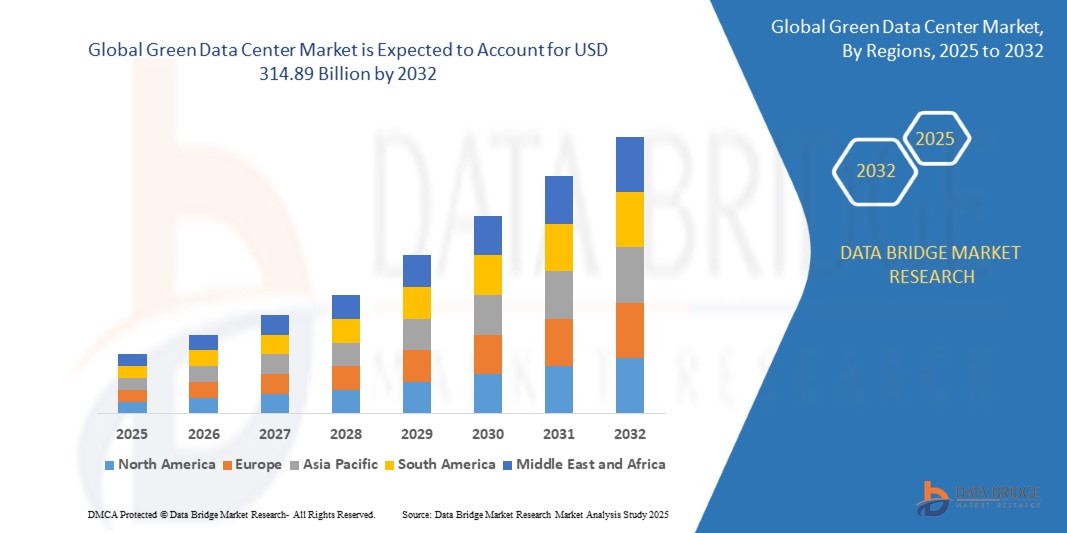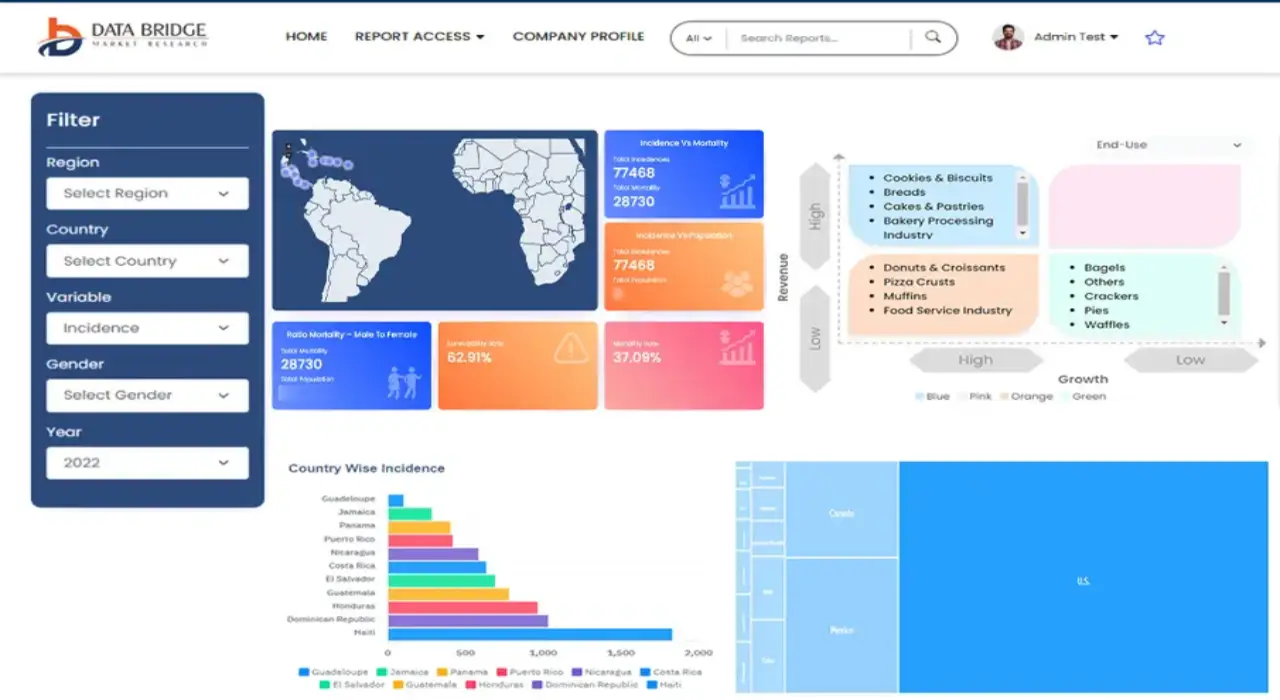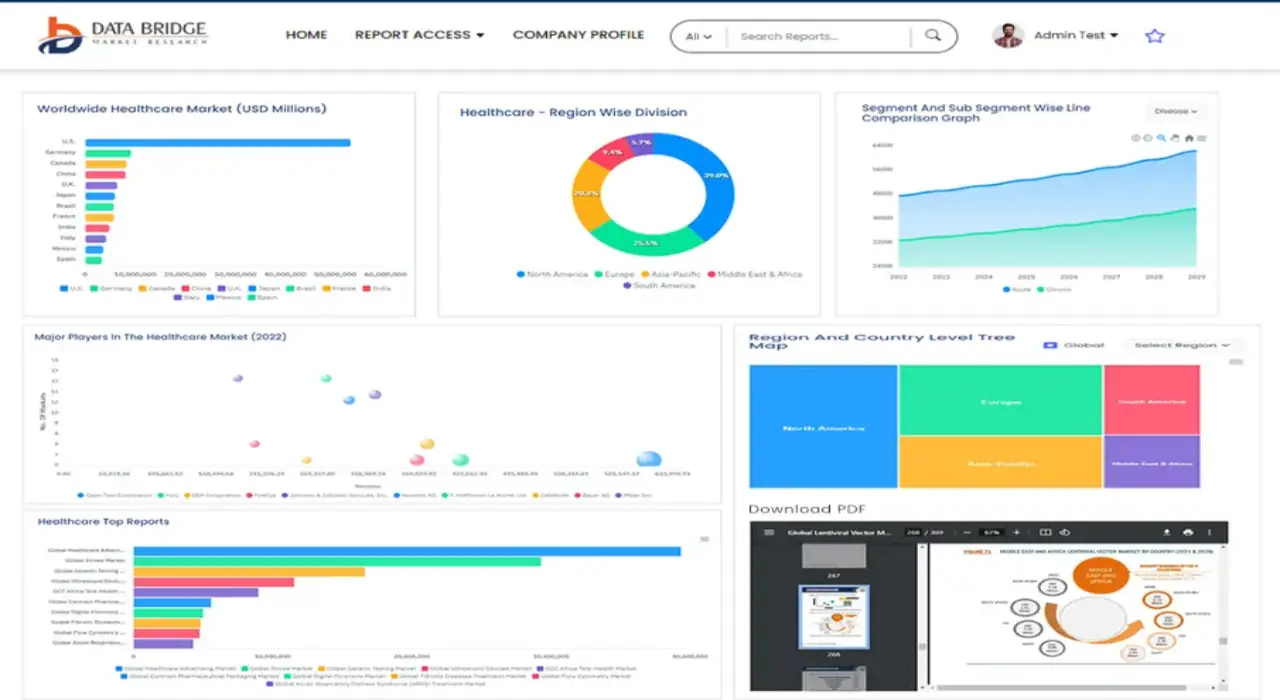Global Green Data Center Market
시장 규모 (USD 10억)
연평균 성장률 :
% 
 USD
51.86 Billion
USD
314.89 Billion
2024
2032
USD
51.86 Billion
USD
314.89 Billion
2024
2032
| 2025 –2032 | |
| USD 51.86 Billion | |
| USD 314.89 Billion | |
|
|
|
>Global Green Data Center Market Segmentation, By Component (Solution and Services), Enterprise Size (Large Enterprises and Small and Medium Enterprises (SMEs)), End-use (BFSI, Retail, IT 7 Telecom, Healthcare, Manufacturing, Government and Defense, and Others) – Industry Trends and Forecast to 2032
Green Data Center Market Analysis
The Green Data Center Market is witnessing significant growth, driven by increasing environmental awareness and the adoption of sustainable practices across industries. A green data center incorporates energy-efficient technologies, renewable energy sources, and advanced cooling systems to minimize environmental impact. Companies are focusing on reducing their carbon footprints by investing in innovative technologies such as liquid cooling, AI-driven energy management, and renewable power integration. Recent advancements in the field include the development of heat recovery systems that repurpose waste heat from data centers for other applications, enhancing overall energy efficiency. For instance, Hewlett Packard Enterprise and Danfoss have introduced modular heat recovery solutions tailored for sustainable IT infrastructures. In addition, technologies such as AI-powered cooling systems optimize energy consumption in real-time, further improving operational efficiency. The market's expansion is also fueled by government regulations promoting eco-friendly practices and increasing corporate social responsibility initiatives. For instance, Europe and North America lead in green data center adoption due to stringent emission norms and incentives for renewable energy use. As sustainability becomes a priority globally, the demand for green data centers is poised to grow, with Asia-Pacific emerging as a lucrative market due to rapid industrialization and technological adoption.
Green Data Center Market Size
The global green data center market size was valued at USD 51.86 billion in 2024 and is projected to reach USD 314.89 billion by 2032, with a CAGR of 25.29% during the forecast period of 2025 to 2032. In addition to the market insights such as market value, growth rate, market segments, geographical coverage, market players, and market scenario, the market report curated by the Data Bridge Market Research team includes in-depth expert analysis, import/export analysis, pricing analysis, production consumption analysis, and pestle analysis.
Green Data Center Market Trends
“Increasing Integration of Liquid Cooling Technology”
The Green Data Center Market is experiencing a transformative trend with the integration of liquid cooling technology, a game-changer in energy efficiency and sustainability. Liquid cooling systems, which use coolant to manage server temperatures, are replacing traditional air-based cooling methods, significantly reducing energy consumption. For instance, companies such as Asetek, Inc. and Vertiv Group Corp. have introduced advanced liquid cooling solutions capable of handling high-density workloads while maintaining environmental standards. This trend addresses the rising need for eco-friendly operations in data centers as global data consumption surges. Liquid cooling minimizes electricity usage and supports heat recovery for secondary applications, aligning with green initiatives and reducing operational costs. Regions such as North America and Europe are leading this adoption due to stringent emission norms and government incentives. As more organizations prioritize sustainable IT infrastructures, liquid cooling is becoming a pivotal factor in the market’s growth trajectory.
Report Scope and Green Data Center Market Segmentation
|
Attributes |
Green Data Center Key Market Insights |
|
Segments Covered |
|
|
Countries Covered |
U.S., Canada and Mexico in North America, Germany, France, U.K., Netherlands, Switzerland, Belgium, Russia, Italy, Spain, Turkey, Rest of Europe in Europe, China, Japan, India, South Korea, Singapore, Malaysia, Australia, Thailand, Indonesia, Philippines, Rest of Asia-Pacific (APAC) in the Asia-Pacific (APAC), Saudi Arabia, U.A.E, South Africa, Egypt, Israel, Rest of Middle East and Africa (MEA) as a part of Middle East and Africa (MEA), Brazil, Argentina and Rest of South America as part of South America |
|
Key Market Players |
ABB (Switzerland), Asetek Inc. A/S (Denmark), Delta Electronics, Inc. (Taiwan), Digital Realty Trust (U.S.), Cisco Systems, Inc. (U.S.), Dell Inc. (U.S.), Equinix, Inc. (U.S.), Fujitsu (Japan), Hewlett Packard Enterprise Development LP (U.S.), Huawei Technologies Co., Ltd. (China), Hitachi, Ltd. (Japan), IBM (U.S.), Siemens (Germany), Vertiv Group Corp. (U.S.), GRC, Green Revolution Cooling (U.S.), Midas Immersion Cooling (U.S.), Rittal Pvt. Ltd. (Germany), Eaton (Ireland), Nortek Air Solutions, LLC. (U.S.), Lenovo (Hong Kong), Iron Mountain, Inc. (U.S.), Ark Data Centres (U.K.), TATA Consultancy Services Limited (India), Adobe (U.S.), and ARANER (U.A.E.) |
|
Market Opportunities |
|
|
Value Added Data Infosets |
In addition to the market insights such as market value, growth rate, market segments, geographical coverage, market players, and market scenario, the market report curated by the Data Bridge Market Research team includes in-depth expert analysis, import/export analysis, pricing analysis, production consumption analysis, and pestle analysis. |
Green Data Center Market Definition
A Green Data Center is a facility designed for storing, managing, and distributing data in a manner that minimizes its environmental impact. It incorporates energy-efficient technologies, renewable energy sources, and sustainable practices to reduce power consumption, carbon emissions, and operational costs. These centers utilize advanced cooling systems, such as liquid cooling or free cooling, energy-efficient hardware, and waste management strategies to achieve high efficiency and eco-friendliness.
Green Data Center Market Dynamics
Drivers
- Increasing Demand for Data Storage and Storage Space
The increasing demand for data storage and storage space is a significant driver for the green data center market. With the rapid growth of digital transformation, businesses and consumers are generating and accessing vast amounts of data, leading to the need for more efficient and scalable data storage solutions. For instance, the proliferation of cloud computing services, streaming platforms, and the Internet of Things (IoT) has exponentially increased the volume of data that requires processing and storage. This rising demand has prompted organizations to build more data centers that meet capacity needs and do so sustainably. Companies are now focusing on integrating renewable energy sources, implementing energy-efficient cooling systems, and utilizing smart infrastructure to reduce carbon footprints and energy consumption. These practices help address the escalating energy demands of data centers while aligning with environmental goals. Therefore, the surge in data storage needs drives the adoption of eco-friendly technologies and fuels growth in the green data center market.
- Growing Focus on Reducing Carbon Emissions and Energy Consumption
The growing focus on reducing carbon emissions and energy consumption has emerged as a key driver for the green data center market, as businesses and governments worldwide prioritize sustainability. With data centers consuming approximately 1% of the world's total electricity and contributing significantly to global carbon emissions, there is a pressing need for energy-efficient solutions. Companies are adopting innovative practices such as liquid cooling, renewable energy integration, and AI-driven energy management systems to optimize power usage and minimize environmental impact. For instance, Google has implemented carbon-neutral strategies for its data centers, utilizing AI to improve energy efficiency and relying on 100% renewable energy for operations. These initiatives align with global sustainability goals and help organizations reduce operational costs, attract eco-conscious consumers, and comply with stringent environmental regulations, further driving the adoption of green data center technologies.
Opportunities
- Growing Pressure from Regulatory Bodies and Governments
Growing pressure from regulatory bodies and governments to adopt sustainable practices has created a significant opportunity for the green data center market. Stricter environmental regulations, such as the European Union’s Green Deal and the U.S. Energy Star certification for data centers, are encouraging companies to transition to energy-efficient and low-carbon technologies. For instance, the EU aims to make all data centers climate-neutral by 2030, pushing organizations to adopt renewable energy, advanced cooling techniques, and optimized energy management systems. Similarly, in the U.S., states such as California have implemented stringent energy efficiency standards for data centers, incentivizing companies to innovate and comply. These regulatory pressures are not just challenges and open avenues for market players to develop and offer eco-friendly solutions, positioning themselves as leaders in sustainable operations. Consequently, the push from governments and regulators is driving the growth and adoption of green data centers globally.
- Increasing Technological Advancements
Technological advancements have significantly enhanced the viability and attractiveness of green data centers, creating new opportunities for market growth. Innovations such as AI-driven energy management systems help optimize power usage by analyzing real-time data and automatically adjusting operations to reduce energy waste. For instance, companies such as Schneider Electric and Siemens have incorporated advanced AI technologies to improve the energy efficiency of their data centers. In addition, the integration of renewable energy sources such as solar panels and wind turbines allows data centers to operate with minimal reliance on non-renewable energy, further reducing their carbon footprint. These technologies support sustainability and offer cost savings by decreasing long-term energy expenses. As businesses prioritize eco-friendly practices and seek ways to meet stringent environmental regulations, green data centers equipped with cutting-edge technology present a compelling solution, driving growth and positioning the market as a lucrative opportunity for enterprises aiming to achieve environmental and economic goals.
Restraints/Challenges
- High initial investment
High initial investment is a significant challenge in the green data center market, as the transition to sustainable infrastructure often involves substantial upfront costs. Implementing advanced energy-efficient systems, renewable energy sources such as solar or wind power, and cooling technologies can be prohibitively expensive for many organizations. For instance, building a new data center designed from the ground up to be energy-efficient and compliant with sustainability certifications requires investments in specialized equipment, sustainable materials, and construction processes that are more costly than traditional data center setups. This high initial cost can deter businesses, especially smaller companies with limited budgets, from adopting green solutions, despite the long-term savings on operational expenses. In addition, the return on investment (ROI) for green data centers is typically longer than for conventional facilities, making it harder for some companies to justify the expense. This high initial investment is, therefore, a key market challenge that impacts the growth and expansion of green data centers.
- Geographical Limitations
Geographical limitations are a key challenge in the green data center market, as the availability and accessibility of renewable energy resources vary widely across regions. For instance, data centers located in areas with limited access to solar or wind power may face difficulties in integrating these sustainable energy sources into their operations. A data center in a region with long periods of low sunlight or minimal wind speeds may struggle to rely on these renewable options for consistent power supply, potentially requiring the addition of backup fossil-fuel generators or other non-renewable solutions to ensure reliability. This dependence can undermine the sustainability goals of the facility and increase operational costs. In addition, the infrastructure required to support green technologies, such as solar panel installations or energy storage systems, may be limited in certain locations, creating a barrier for data center operators who wish to adopt greener practices. These geographical constraints can restrict the growth of the green data center market, as companies may be unable to establish sustainable operations in specific regions, impacting the widespread adoption of environmentally friendly data center practices.
This market report provides details of new recent developments, trade regulations, import-export analysis, production analysis, value chain optimization, market share, impact of domestic and localized market players, analyses opportunities in terms of emerging revenue pockets, changes in market regulations, strategic market growth analysis, market size, category market growths, application niches and dominance, product approvals, product launches, geographic expansions, technological innovations in the market. To gain more info on the market contact Data Bridge Market Research for an Analyst Brief, our team will help you take an informed market decision to achieve market growth.
Green Data Center Market Scope
The market is segmented on the basis of component, enterprise size, and end-use. The growth amongst these segments will help you analyse meagre growth segments in the industries, and provide the users. The growth amongst these segments will help you analyze meagre growth segments in the industries and provide the users with a valuable market overview and market insights to help them make strategic decisions for identifying core market applications.
Component
- Solution
- Monitoring and Management System
- Cooling System
- Networking System
- Power Systems
- Others
- Services
- Installation and Deployment
- Consulting
- Support and Maintenance
Enterprise Size
- Large Enterprises
- Small and Medium Enterprises (SMEs)
End-use
- BFSI
- Retail
- IT 7 Telecom
- Healthcare
- Manufacturing
- Government and Defense
- Others
Green Data Center Market Regional Analysis
The market is analyzed and market size insights and trends are provided by country, component, enterprise size, and end-use. The growth amongst these segments will help you analyse meagre growth segments in the industries, and provide the users as referenced above.
The countries covered in the market report are U.S., Canada, Mexico in North America, Germany, Sweden, Poland, Denmark, Italy, U.K., France, Spain, Netherland, Belgium, Switzerland, Turkey, Russia, Rest of Europe in Europe, Japan, China, India, South Korea, New Zealand, Vietnam, Australia, Singapore, Malaysia, Thailand, Indonesia, Philippines, Rest of Asia-Pacific (APAC) in Asia-Pacific (APAC), Brazil, Argentina, Rest of South America as a part of South America, U.A.E, Saudi Arabia, Oman, Qatar, Kuwait, South Africa, Rest of Middle East and Africa (MEA) as a part of Middle East and Africa (MEA).
North America is dominating the global green data center market, driven by its advanced infrastructure, strong commitment to sustainability, and early adoption of eco-friendly technologies. The region benefits from significant investments in renewable energy sources and energy-efficient data center practices, supported by government regulations and incentives that promote environmental responsibility. Countries such as the U.S. and Canada are at the forefront, implementing cutting-edge cooling systems, optimizing energy usage, and integrating solar and wind power to power data centers. In addition, major tech companies headquartered in North America are committed to achieving carbon neutrality and are pioneering innovations in green data center technology, further strengthening the market's growth. This commitment to reducing carbon footprints and enhancing energy efficiency positions North America as a dominant force in the global green data center market.
Asia Pacific is projected to exhibit the highest compound annual growth rate (CAGR) in the global green data center market due to rapid industrialization, increased energy consumption, and a strong push for sustainable and energy-efficient infrastructure. The region's growing focus on environmental sustainability, government initiatives promoting green practices, and investments in renewable energy are driving the adoption of eco-friendly data center solutions. Countries such as China, Japan, and India are leading the way in implementing advanced cooling techniques, renewable energy integration, and energy-efficient technologies to support the growing demand for data storage and processing while reducing environmental impact. This trend indicates a robust market expansion and signifies Asia Pacific's pivotal role in the future of sustainable data center development.
The country section of the report also provides individual market impacting factors and changes in market regulation that impact the current and future trends of the market. Data points such as down-stream and upstream value chain analysis, technical trends and porter's five forces analysis, case studies are some of the pointers used to forecast the market scenario for individual countries. Also, the presence and availability of global brands and their challenges faced due to large or scarce competition from local and domestic brands, impact of domestic tariffs and trade routes are considered while providing forecast analysis of the country data.
Green Data Center Market Share
The market competitive landscape provides details by competitor. Details included are company overview, company financials, revenue generated, market potential, investment in research and development, new market initiatives, global presence, production sites and facilities, production capacities, company strengths and weaknesses, product launch, product width and breadth, application dominance. The above data points provided are only related to the companies' focus related to market.
Green Data Center Market Leaders Operating in the Market Are:
- ABB (Switzerland)
- Asetek Inc. A/S (Denmark)
- Delta Electronics, Inc. (Taiwan)
- Digital Realty Trust (U.S.)
- Cisco Systems, Inc. (U.S.)
- Dell Inc. (U.S.)
- Equinix, Inc. (U.S.)
- Fujitsu (Japan)
- Hewlett Packard Enterprise Development LP (U.S.)
- Huawei Technologies Co., Ltd. (China)
- Hitachi, Ltd. (Japan)
- IBM (U.S.)
- Siemens (Germany)
- Vertiv Group Corp. (U.S.)
- GRC, Green Revolution Cooling (U.S.)
- Midas Immersion Cooling (U.S.)
- Rittal Pvt. Ltd. (Germany)
- Eaton (Ireland)
- Nortek Air Solutions, LLC. (U.S.)
- Lenovo (Hong Kong)
- Iron Mountain, Inc. (U.S.)
- Ark Data Centres (U.K.)
- TATA Consultancy Services Limited (India)
- Adobe (U.S.)
- ARANER (U.A.E.)
Latest Developments in Green Data Center Market
- In June 2024, Hewlett Packard Enterprise partnered with Danfoss to introduce HPE IT Sustainability Services - Data Center Heat Recovery, a turnkey heat recovery module designed to help organizations manage and repurpose excess heat while transitioning to more sustainable IT infrastructures
- In May 2024, Microsoft launched its first data center region in Mexico and Central Mexico, making scalable, highly available, and resilient cloud services accessible to organizations worldwide
- In December 2023, Vertiv completed the acquisition of CoolTera Ltd., a company specializing in liquid cooling solutions for high-density computing and AI. This strategic move enhanced Vertiv's capabilities in high-density cooling, allowing the company to better meet the needs of global data center customers and support AI at scale
- In December 2023, Liberation Technology Services (LTS) collaborated with E-New Data Corp. to build an innovative, eco-friendly data center facility, aimed at reducing power and water usage compared to conventional data centers
- In February 2022, Fujitsu Ltd. advanced the development of energy-efficient photonics smart network interface cards (NICs) and CPUs under its NEO program to address the challenges of increasing power consumption in data centers. This breakthrough solution supports the creation of green data centers by improving energy efficiency, enhancing capacity, and reducing latency, contributing to a more sustainable society
SKU-
세계 최초의 시장 정보 클라우드 보고서에 온라인으로 접속하세요
- 대화형 데이터 분석 대시보드
- 높은 성장 잠재력 기회를 위한 회사 분석 대시보드
- 사용자 정의 및 질의를 위한 리서치 분석가 액세스
- 대화형 대시보드를 통한 경쟁자 분석
- 최신 뉴스, 업데이트 및 추세 분석
- 포괄적인 경쟁자 추적을 위한 벤치마크 분석의 힘 활용
연구 방법론
데이터 수집 및 기준 연도 분석은 대규모 샘플 크기의 데이터 수집 모듈을 사용하여 수행됩니다. 이 단계에는 다양한 소스와 전략을 통해 시장 정보 또는 관련 데이터를 얻는 것이 포함됩니다. 여기에는 과거에 수집한 모든 데이터를 미리 검토하고 계획하는 것이 포함됩니다. 또한 다양한 정보 소스에서 발견되는 정보 불일치를 검토하는 것도 포함됩니다. 시장 데이터는 시장 통계 및 일관된 모델을 사용하여 분석하고 추정합니다. 또한 시장 점유율 분석 및 주요 추세 분석은 시장 보고서의 주요 성공 요인입니다. 자세한 내용은 분석가에게 전화를 요청하거나 문의 사항을 드롭하세요.
DBMR 연구팀에서 사용하는 주요 연구 방법론은 데이터 마이닝, 시장에 대한 데이터 변수의 영향 분석 및 주요(산업 전문가) 검증을 포함하는 데이터 삼각 측량입니다. 데이터 모델에는 공급업체 포지셔닝 그리드, 시장 타임라인 분석, 시장 개요 및 가이드, 회사 포지셔닝 그리드, 특허 분석, 가격 분석, 회사 시장 점유율 분석, 측정 기준, 글로벌 대 지역 및 공급업체 점유율 분석이 포함됩니다. 연구 방법론에 대해 자세히 알아보려면 문의를 통해 업계 전문가에게 문의하세요.
사용자 정의 가능
Data Bridge Market Research는 고급 형성 연구 분야의 선두 주자입니다. 저희는 기존 및 신규 고객에게 목표에 맞는 데이터와 분석을 제공하는 데 자부심을 느낍니다. 보고서는 추가 국가에 대한 시장 이해(국가 목록 요청), 임상 시험 결과 데이터, 문헌 검토, 재생 시장 및 제품 기반 분석을 포함하도록 사용자 정의할 수 있습니다. 기술 기반 분석에서 시장 포트폴리오 전략에 이르기까지 타겟 경쟁업체의 시장 분석을 분석할 수 있습니다. 귀하가 원하는 형식과 데이터 스타일로 필요한 만큼 많은 경쟁자를 추가할 수 있습니다. 저희 분석가 팀은 또한 원시 엑셀 파일 피벗 테이블(팩트북)로 데이터를 제공하거나 보고서에서 사용 가능한 데이터 세트에서 프레젠테이션을 만드는 데 도움을 줄 수 있습니다.















